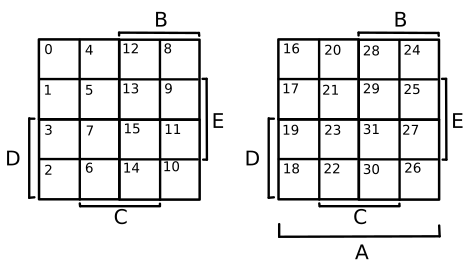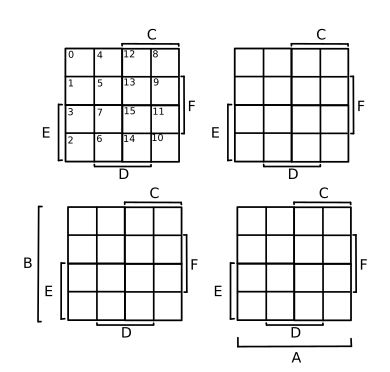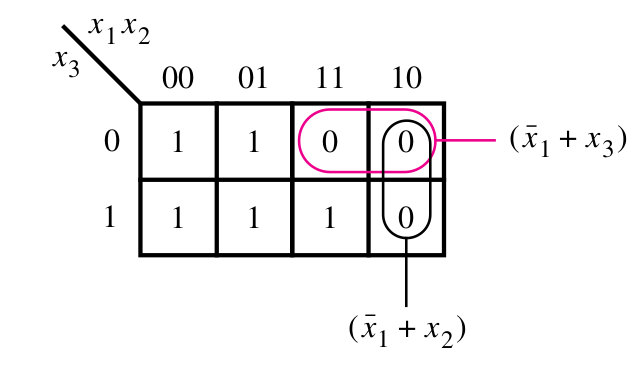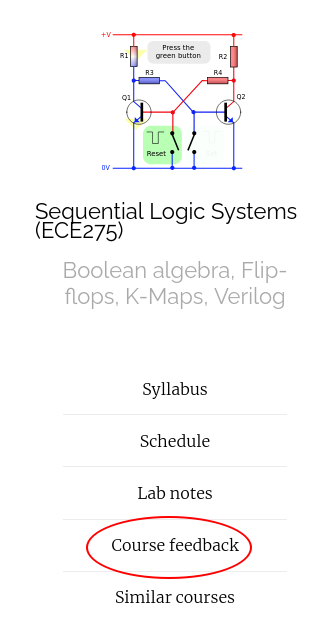ECE 275: More about K-maps
Website: https://vikasdhiman.info/ECE275-Sequential-Logic/
\[
\newcommand{\bx}{\bar{x}}
\newcommand{\by}{\bar{y}}
\newcommand{\bz}{\bar{z}}
\]
Karnaugh Maps terminology
- Literal : a single variable or its complement.
-
Implicant: A product term that indicates for which \( f = 1 \)
All minterms are implicants. - Prime Implicant (PI): If an implicant cannot be "combined" into fewer literals.
- Essential Prime Implicant (EPI): A PI that is the only PI to cover some 1 on the K-map
- Cover : PI's that account for all \( f = 1 \)
Example: \( f = \sum m(0, 1, 2, 3, 7) = \bx_1 + x_1 x_2 x_3\)
Karnaugh Maps terminology
- Literal : a single variable or its complement.
-
Implicant: A product term that indicates for which \( f = 1 \)
All minterms are implicants. - Prime Implicant (PI): If an implicant cannot be "combined" into fewer literals.
- Essential Prime Implicant (EPI): A PI that is the only PI to cover some 1 on the K-map.
- Cover : PI's that account for all \( f = 1 \).
- Cost : Number of gates and inputs excluding input complements.
Example: \( f = \sum m(0, 1, 2, 3, 7) = \bx_1 + x_1 x_2 x_3\)
| \(\bar{x_1}\) | \(x_1 \) | |||
|---|---|---|---|---|
| \(\bar{x_2}\) | \(x_2 \) | \(\bar{y}\) | ||
| \(\bar{x_3}\) | 1 | 1 | 0 | 0 |
| \(x_3\) | 1 | 1+1 | 1 | 0 |
- Literals are \( \bx_1, x_1, x_2, x_3\)
- Implicants are \( \bx_1 \), \(\bx_1 x_2 x_3, \dots \), \( x_1 x_2 x_3\)
- PI's are \( \bx_1 \) and \( x_2 x_3 \)
- EPI's are \( \bx_1 \) and \( x_2 x_3 \)
- Cost is 9 = 6 inputs + 2 AND gate + 1 OR gate
Cost = 2 AND + 2 OR + 1 NOT + 9 inputs = 14
Cost = 3 OR + 1 AND + (8+3) inputs = 15
K-map neighborhood property
\begin{align}
f &= x_1 \bx_3 \bx_4 + x_2 \bx_3 \bx_4 + x_1 \bx_2 \bx_3 &
\end{align}
| \(\bar{x}_1\) | \(x_1 \) | ||||
|---|---|---|---|---|---|
| \(\bar{x}_2\) | \(x_2 \) | \(\bar{x}_2\) | |||
| \(\bar{x}_3\) | \(\bar{x}_4\) | 0 | 1 | 1 | 1 |
| \(x_4\) | 0 | 0 | 0 | 1 | |
| \(x_3\) | 0 | 0 | 0 | 0 | |
| \(\bar{x}_4\) | 0 | 0 | 0 | 0 | |
Adjacent cells of K-maps differ only by one variable
Karnaugh Maps for 5-variable

Karnaugh Maps for 6-variable

K-Maps for POS minimization
\[ f(x_1, x_2, x_3) = \prod M(4, 5, 6) \] \[ f(x_1, x_2, x_3) = (\bx_1 + x_3)(\bx_1 + x_2) \]
\[ f(x_1, x_2, x_3) = (\bx_1 + x_3)(\bx_1 + x_2) \]
Cost = 9 = 6 inputs + 2 OR gate + 1 AND gate
| \(\bar{x}_1\) | \(x_1 \) | |||
|---|---|---|---|---|
| \(\bar{x}_2\) | \(x_2 \) | \(\bar{x}_2\) | ||
| \(\bar{x}_3\) | 0 | 0 | 1 | 1 |
| \(x_3\) | 0 | 0 | 0 | 1 |
Minimization process
- Draw K-map for \( f \) and \( \bar{f} \)
- Find cost for each. Choose the minimum cost implementation.
Incompletely specified functions
\[f(x_1, \dots, x_4) = \sum m(2, 4, 5, 6, 10) + D(12, 13, 14, 15).\]| \(\bar{x}_1\) | \(x_1 \) | ||||
|---|---|---|---|---|---|
| \(\bar{x}_2\) | \(x_2 \) | \(\bar{x}_2\) | |||
| \(\bar{x}_3\) | \(\bar{x}_4\) | 0 | 1 | d | 0 |
| \(x_4\) | 0 | 1 | d | 0 | |
| \(x_3\) | 0 | 0 | d | 0 | |
| \(\bar{x}_4\) | 1 | 1 | d | 1 | |
Cost = 6 inputs + 2 AND + 1 OR = 7
| \(\bar{x}_1\) | \(x_1 \) | ||||
|---|---|---|---|---|---|
| \(\bar{x}_2\) | \(x_2 \) | \(\bar{x}_2\) | |||
| \(\bar{x}_3\) | \(\bar{x}_4\) | 0 | 1 | d | 0 |
| \(x_4\) | 0 | 1 | d | 0 | |
| \(x_3\) | 0 | 0 | d | 0 | |
| \(\bar{x}_4\) | 1 | 1 | d | 1 | |
Cost = 6 inputs + 2 OR + 1 AND = 7
Thanks, Questions, Feedback?
https://vikasdhiman.info/ECE275-Sequential-Logic/